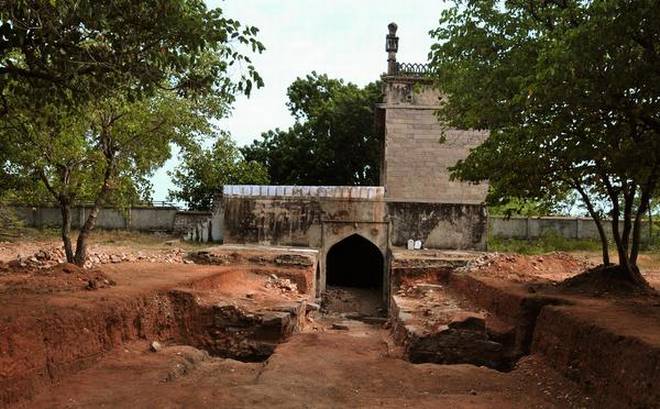Golconda
This is a collection of articles archived for the excellence of their content. |
Contents |
Bagh-e-Naya Qila
Mapping the contours
Serish Naninsetti, April 17, 2018: The Hindu

From: Serish Naninsetti, April 17, 2018: The Hindu
In another instance of modern technology coming to the aid of medieval heritage, the Archaeological Survey of India (ASI) will be using Ground Penetrating Radar (GPR) to map the contours of the area around the Bagh-e-Naya Qila excavated garden inside the Golconda Fort. It has roped in the Indian Institute of Technology-Madras (IIT-M) to carry out the mapping.
This medieval garden in Hyderabad is the only one of its kind still intact. All the others – built during the Qutb Shahi rule (1518-1687) -- have either been built over or have disappeared. The contour mapping was necessitated by the impending advance of the Hyderabad Gold Club, which wants to expand its 18-hole course into a 21-hole one by taking over some of the land adjoining the Bagh-e-Naya Qila site. A GPR map would reveal any medieval relics that may lie buried under the ground, and could thus be saved by the ASI.
“The Hyderabad Golf Club, which has built a golf course in the Naya Qila area, wants to add a few more holes on the other side of the garden. We don’t want to lose any more history. We want to ensure that there are no relics of the Bagh-e-Naya Qila underneath and hence we are planning to map the area with GPR. We would have liked to do this with a Light Detection and Radar (LiDAR) but for that we need the permission of the Defence Ministry,” said ASI Superintending Archaeologist Milan Kumar Chauley.
The Naya Qila garden inside Golconda Fort was built by successive rulers of the Deccan and is one of the few symmetrical gardens extant. In 2014, when the ASI excavated the area after diverting the water flow, it discovered water channels, settlement tanks, walkways, fountains, gravity pumps, and a host of other garden relics.
An earlier excavation unearthed gold coins in the area where the golf course has been created. According to author Ali Akbar Husain, the Naya Qila area also has multiple chabootras (raised platforms) which are remains of garden structures that pre-date the Qutb Shahi rule. In the 1940s, the garden was even used for celebrating Basant Panchami.
The team from IIT-Madras will do a preliminary survey to ascertain the path for the contour-mapping. “We have told the IIT-Madras team that the survey and mapping have to be finished before the monsoon sets in. We will do the preliminary study by end of this month and the mapping might be completed in May,” Mr. Chauley said.
While there is a semi-collapsed ‘baradari’ (a gazebo-like structure with many pillars) in the garden, historians believe that another baradari might lie buried in the ground. GPR uses electromagnetic radiation in the microwave frequency for imaging sub-surface area.
Golconda fort
Pile of garbage at the Moti Darwaza

Photo Credit- K.V.S. GIRI
From: Serish Nanisetti, Hyderabad’s iconic monument has never smelled so bad in its 500-year history, July 18, 2018: The Hindu
The Golconda Fort in Hyderabad is a treasure trove of tales about valour and betrayal. It is a standing monument to medieval art, craftsmanship, techniques of warfare, and construction know-how. But today the iconic heritage site is sinking under filth and garbage, so much so that tourists walk through its precincts with handkerchiefs to their noses.
A rancid smell pervades the entire 13 sq km fort area. Residents in the locality live with the foul odour even as garbage keeps piling up and sewerage lines remain clogged.
Even the Fort’s moat serves a function never imagined by its original architects — it is a massive garbage bin.
The Moti Darwaza, a narrow ‘S’-shaped gateway originally built to keep rampaging elephants out, is permeated by stench from garbage bins placed by the Greater Hyderabad Municipal Corporation (GHMC). “Those in cars can zip away, but for students of the nearby Shangrila and Gowtam School, walking is an ordeal. If they walk on either side of the road, they could slip and fall on the garbage,” says Muhammad Altafuddin, who runs a restaurant.
The population of the Golconda area is 2,13,359 as per the 2011 Census, while GHMC officials peg the current population at over three lakh.
“Every day we lift about 10 tonnes of garbage using small tipper autos — about 1.5 tonnes from the houses and the rest from six public bins,” says a senior GHMC official.
Waiting for old maps
Sewage continues to flow on the main road, shocking visitors. “I am trying to get older fort maps. These had marked out areas under the the Archaeological Survey of India and the Army. If revenue officials give the information, we can remove the encroachments,” says Milan Kumar Chauley, Superintending Archaeologist, ASI.